Llansadwrn is a small village which sits about three miles from Llangadog in the picturesque Towy Valley. The War Memorial is in the form of a Granite Obelisk which is situated just outside the grounds of St. Sadwrn Churchyard, and commemorates the men of the village who fell during three wars: the Boer War, the Great War and World War Two.

The Boer War, 1899-1902
Phillip Davies, Private, 7565, 3rd Battalion, Grenadier Guards. Philip was the son of William and Eliza Davies, of Cwmbranfach, Llansadwrn. He was Killed in Action during the Battle of Belmont, on 23 November 1899, aged 26, and is buried at West End Cemetery, Kimberley, Northern Cape.
The Great War, 1914-1918
William Barratt, Private, 288052, Welsh Regiment. William was from Birmingham, and was residing at Llansadwrn when he married Catherine Kate Thompson, of Plasnewydd, Llansadwrn in 1914. William enlisted at Llandovery into the army, and was posted to the 1/6th Battalion, Welsh Regiment, which had been in France since 29 October 1914. On 5 July 1915 they transferred to 84 Brigade, 28th Division, and on 23 October 1915 transferred again, to 3 Brigade, 1st Division, becoming Divisional Pioneers on 15 May 1916. William was wounded during the Second Battle of Passchendaele and Died of Wounds at the Casualty Clearing Station at Dozinghem on 11 November 1917. He is buried at Dozinghem Military Cemetery, Belgium.
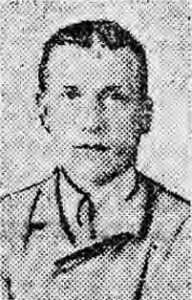
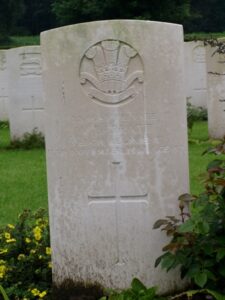
David Thomas Henry Bendle, Private, 18380, Welsh Regiment. David was born at Llansadwrn, the son of James and Eleanor Bendle. The family had moved to Brynawel, Glanamman prior to the war, and David enlisted at Ammanford into the 9th Battalion, Welsh Regiment and landed in France with the battalion on 18 July 1915. David was probably wounded at some time, before returning to France and joining the 2nd Battalion, Welsh Regiment, which was attached to 3 Brigade, 1st Division. The battalion had fought in almost every major action of the war, and was in Flanders when the German offensive hit the area on 9 April 1918. The Division was caught in the Battle of Estaires, but the onslaught was too much, and so the British pulled back, fighting at the Battles of Hazebrouck and of Bethune. David was Killed in Action in Flanders on 23 July 1918 aged 21, and is buried at Cambrin Military Cemetery. His superior officers paid a glowing tribute to his bravery and popularity. David’s parents later retired to Dilkasha, Blackpill, Swansea. David is not commemorated at Llansadwrn.
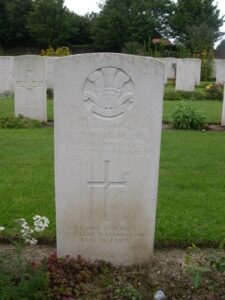
Benjamin Trevor Davies, Gunner, 123915, Royal Garrison Artillery. Benjamin was the son of Daniel and Esther Davies, of Pantyrhendre, Llansadwrn. He resided at Manchester House, Caio prior to the war, where he worked as a grocer. Benjamin enlisted at Llandovery on 21 October 1916 into the Royal Garrison Artillery. On 17 April 1917 he landed in France, where he entrained for Marseilles. Benjamin then sailed to Egypt before joining the 304th Siege Battery, Royal Garrison Artillery, which was part of the XCV Heavy Artillery Group. Benjamin fought in the Mesopotamian theatre, where he was wounded, and he sadly died of Meningitis following wounds on 5 March 1918, aged only 21. He is buried at Ramleh War Cemetery, Israel.
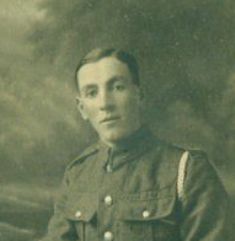
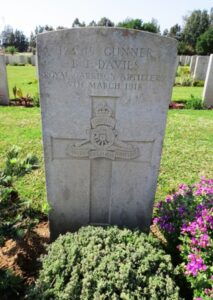
John Davies, Private, 52974, Welsh Regiment. John was the son of Roderick and Mary Davies, of Pantygawmil, Llansadwrn. He enlisted at Llandovery into the 3rd Battalion, the Welsh Regiment, which was a Home Service unit. John Died at Rhyl of sickness on 21 February 1917, aged 28, and is buried at Llansadwrn Churchyard.
William Durance, Private, 26127, East Surrey Regiment. William was the son of William and Valey Durance, of 2, Arundel Place, Arundel Square, Barnsbury, London. He worked at Abermarlais Park, and enlisted at Whitehall into the army. William was posted to France at some time during 1916, joining the 1st Battalion, East Surrey Regiment, which was on the Somme attached to 14 Brigade, 5th Division. On 1 July 1916 the Battle of the Somme opened, and the Division moved south fighting at High Wood, Guillemont, Flers-Courcelette, Morval and Le Transloy. On 5 October, after suffering heavy casualties, the Division moved to Festubert, where they remained until March 1917. They next saw action at the Battle of Arras, fighting at the Battle of Vimy in April 1917, and the attack on La Coulette. On 3 May they fought in the Third Battle of the Scarpe, and captured Oppy Wood. On 7 September, they were pulled out of the line again, and moved north, where they fought at Passchendaele. William was killed in action on 10 October 1917, aged just 19. His body was lost in the Flanders mud, so he is remembered on the Tyne Cot Memorial, Belgium.
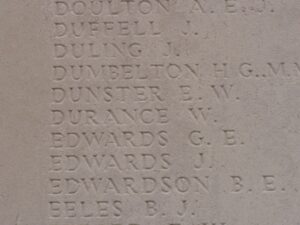
John Evans, Private, 45037, Welsh Regiment. John was the son of John and Harriet Evans, of Llethyfagwyren, Llansadurnen, Llanwrda. After enlisting into the army, John was posted to France, where he joined the 2nd Battalion, Welsh Regiment, probably after the Somme offensive of 1916. The battalion had been on the Western Front since the outbreak of war, attached to 3 Brigade, 1st Division, and had seen plenty of fighting. John was with the battalion when it followed the German retreat to the Hindenburg Line in early 1917, before moving to the Flanders Coast during the summer of 1917. While training on the coast, the Battle of Third Ypres had stalled in the mire, and the Division was recalled to Ypres, where they fought at the Second Battle of Passchendaele. After spending another winter in Flanders, they were near Estaires when the German Spring Offensive caught them, fighting through the Battles of Estaires, Hazebrouck, and Bethune before being moved South again to Arras, fighting at the Battle of Drocourt-Queant, and at the Battle of Epehy, after the tide had been turned in the favour of the Allies. John was killed during the advance on the Hindenburg Line, on 25 September 1918, aged 26. He is buried at Roisel Communal Cemetery Extension, France. John does not seem to be commemorated locally.
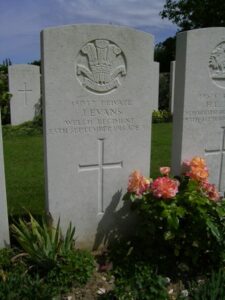
Thomas Vicars Hunter, Captain, Royal Air Force. Thomas was born in London on 2 April 1897, the son of Henry Charles Vicars Hunter, J.P., and the Hon. Mrs. Florence Edith Hunter, of Abermarlais Park, Llangadock. Thomas was educated at Ladycross and Eton, which he left early at the age of 17 for a Commission at Sandhurst, joining the 5th Battalion, the Rifle Brigade. Soon after being gazetted, he broke his leg in a motorcycle accident, which necessitated the amputation of his badly injured leg. This didn’t stop him though, as he returned to service in October 1916, but quickly discovered that he was hampered by the loss of his leg, and so he volunteered for the Royal Flying Corps in February 1917. He gained his wings in May, and served in France flying scouts, with 66 Squadron. Thomas was gazetted Flight Commander in September, and in November 1917 was posted to Italy with his Squadron. Sadly Thomas was Killed in Action there on 5 December 1917, aged just 20, and is buried at Carmignano Di Brenta Communal Cemetery, Italy.
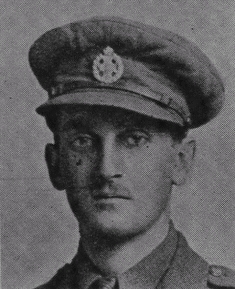
Henry Jones, Private, 474271, Canadian Infantry. Henry was born on 21 July 1884, the son of William and Gwenllian Jones, of Bank-y-Gwin, and had migrated to Canada prior to the outbreak of war. He enlisted at Saskatoon on 3 April 1916 into the 72nd Battalion (British Columbia), Canadian Infantry, which was part of the 12th Brigade, 4th Canadian Division. Henry would have arrived in France in time to take part in the Divisions first battle at Le Transloy, on the Somme, in October 1916. They then fought at the Battle of the Ancre Heights, where the Canadians captured Regina Trench, before taking part in the Battle of the Ancre. Henry was wounded in action at the Battle of the Ancre, and died of wounds on 16 November 1916, aged 32. He is buried in Aveluy Communal Cemetery Extension, France.
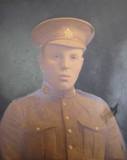
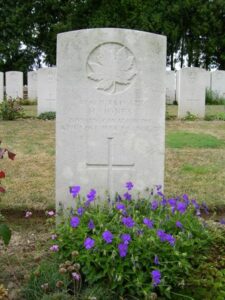
John Jones, Private, 46533, Welsh Regiment. John was the son of Thomas and Hannah Jones, of Pwllau, White Square, Taliaris. He enlisted at Swansea into the army and was posted to France at sometime in 1916, joining the 9th Battalion, Welsh Regiment, which was attached to 58 Brigade, 19th (Western) Division. The division saw terrible fighting on the Somme that year, before moving to Ypres, and took part in the Battle of Messines the following year. John was killed in action during the Battle of the Menin Road, on 21 September 1917, aged 31. His body was lost on the muddy Flanders Battlefield, and so he is remembered on the Tyne Cot Memorial, Belgium.
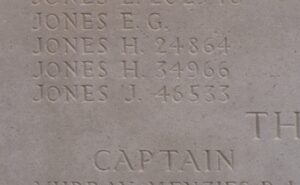
Thomas Kynaston, Sergeant, 12969, South Wales Borderers. Thomas was the son of George and Lucy Kynaston, of 2, Powis Place, Castle Street, Oswestry. He was a Butler who had worked at Liverpool before coming to Abermarlais Park prior to the war. He enlisted at Brecon into the South Wales Borderers soon after the outbreak of war. Thomas was posted to the 4th Battalion, South Wales Borderers, which was attached to 40 Brigade, 13th (Western) Division. On 6 July 1915 the Division landed at Cape Helles, but they returned to Mudros just two weeks later. They then landed at ANZAC Cove on 3 August 1915, and fought at the Battle of Sari Bair, Russell’s Top and Hill 60. Thomas was Killed in Action at ANZAC on 22 August 1915, aged 31, and is remembered on the Helles Memorial, Gallipoli.
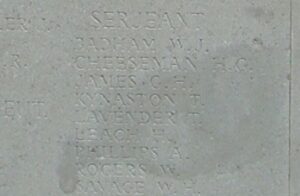
Rees Alban Lewis, Lance Sergeant 49772, Royal Fusiliers. Rees was the son of Rees and Elizabeth Lewis, of Brownhill, Llansadwrnen. He enlisted at Cardiff into the army, and was posted to the 9th Battalion, Royal Fusiliers, which was attached to 36 Brigade, 12th Division. The Division moved to France at the end of May 1915, and relieved the 46th Division at Ploegsteert Wood on 23 June, remaining there until 26 September when they moved to Loos. They fought at Loos until their relief on 15 November, when they moved into reserve at Lillers. On 10 December 1915 they moved to the line at Givenchy, and moved back to Loos in February 1916. By 18 June 1916 the Division was on the Somme, and attacked Ovillers on 2 July 1916. They then fought at Pozieres and Le Transloy, before moving to Arras on 22 August. Here they fought at the Battle of the Scarpe on 9 April 1917, then at Arleux and at the Third Battle of the Scarpe. In November 1917 they took part in the Battle of Cambrai, and this is where Rees was killed in action on 30 November 1917, aged 23. He is buried at Fifteen Ravine British Cemetery, Villers-Plouich, France.
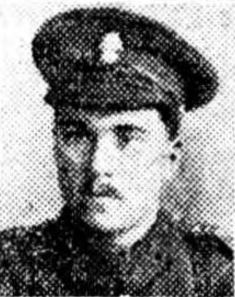
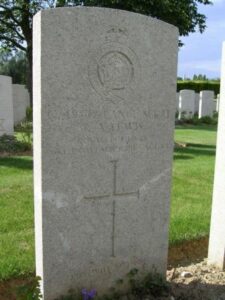
Joshua Williams, Private, 633812, London Regiment. Joshua was born at Llansadwrn in November 1886, the son of William and Eliza Williams. He worked as a Draper, residing at Ty Coch, White Square, Taliaris, Llandilo. Joshua enlisted on 18 November 1915 into the 15th Battalion, London Regiment, and on 5 July 1916, he embarked with the Battalion for France, where he transferred to the 20th Battalion, London Regiment, attached to 141 Brigade, 47th (London) Division. The Division fought on the Somme that year, through the Battles of Flers-Courcelette and Le Transloy, where they captured Eaucourt L’Abbe, and attacked the Butte de Warlencourt. Joshua took ill after these actions, and was admitted to the 2nd Australian General Hospital at Boulogne with influenza. On 2 November 1916 he returned to England, and spent the next few months at the 2nd General Eastern Hospital, Brighton. Joshua was discharged from the army on 26 June 1917, owing to ill health, and was transferred to Beechwood House Hospital, Newport, where he sadly died on 17 September 1917, suffering from Cardiac Failure. He is buried at Taliaris (Holy Trinity) Churchyard. Joshua was accepted for commemoration by the CWGC on 27 May 2011 after his case was put forward to the CWGC by Dave Hanson.
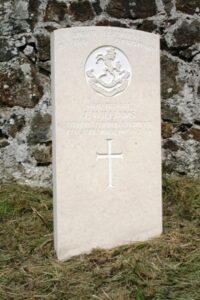
Benjamin Wright, Private, 11479, Welsh Regiment. Benjamin was born at London, but resided at Pwllyfan, Llanwrda prior to the war, where he worked as a Gardener for Mr Hunter at Abermarlais Park. He became the first man from the district to enlist, having enlisted at the outbreak of war at Carmarthen into the 2nd Battalion, Welsh Regiment, which landed in France on 13 August 1914 as part of 3 Brigade, 1st Division. The Division fought at the Battle of Mons, and then during the epic retreat to the Marne, where they helped stop the German Advance before pushing them back to the Aisne. They were then rushed to Ypres, and took part in First Ypres, where the German advance across Flanders was stopped, although at great cost. After a hard first winter in Flanders, the Division fought at the Battle of Aubers in May 1915 then moved to Loos, and took part in the Battle of Loos throughout September and October that year. In 1916 they fought on the Somme, where Benjamin was killed in action on 23 August 1916, aged 27. He is buried in Flatiron Copse Cemetery, Mametz, France.
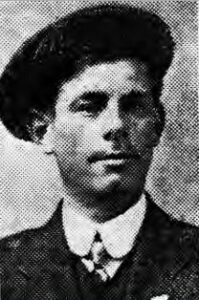
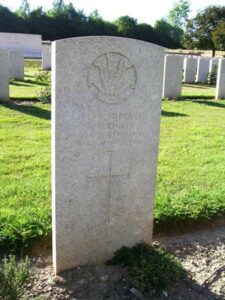
World War Two, 1939-1945
Bertie Daniel Crooks, Driver, T/109158, Royal Army Service Corps. Bertie was the son of William and Catherine Crooks, of Bwlchygwynt. He served with the B.E.F. in France at the outbreak of war, with the 3 Corps Troops Ammunition Company, Royal Army Service Corps. On 25 May 1940, due to the overwhelming superiority of numbers of the advancing Germans, the BEF was ordered to pull back to positions around Dunkirk, to enable the evacuation of the BEF. On 27 May the evacuation from the beached began. Bertie was killed in action during the epic withdrawal to the Dunkirk Beachhead at some time between 28 May and 2 June 1940, aged 28, and is commemorated on the Dunkirk Memorial, France.
William Arthur Davies, Gunner, 1094375, Royal Artillery. William was the son of Oakey and Margaret Davies, of Minyrafon, Llanwrda. He enlisted into the Royal Artillery and was posted to the 72nd Anti Tank Regiment. William fought with the regiment during the North African campaign and took part in the subsequent invasion of Italy. He was killed on 27 August 1944, aged 27, and is buried in Arezzo War Cemetery, Italy.
William Oswald Davies, Private, 4192228, Highland Light Infantry (City of Glasgow Regiment). William was the son of John and Catherine Davies of Llwynhowell. He served with the 2nd Battalion, Highland Light Infantry, which was in Palestine in 1939. The battalion moved to Egypt, and took part in the campaign in North Africa and the Western Desert. The battalion took part in the landings at Sicily in 1943. William was killed in Italy on 22 September 1944. He was 27 years old, and is buried at Mierlo War Cemetery, Italy.
William Richard James, Fusilier, 7044773, Royal Irish Fusiliers. William was born in Fforestfach, Swansea on 17 May 1915, the son of Albert John James and Mary Ellen James (nee Gwenter). Following the death of his father, the family moved to Coventry, where William worked as a power press operator in an engineering works. He enlisted into the army and was posted to the 1st Battalion, Royal Irish Fusiliers, which was attached to the 38th Irish Brigade. The battalion had been in France in 1940, and was evacuated from Dunkirk, and after rebuilding moved to North Africa. It took part in the Western Desert campaign, before taking part in the invasions of Sicily and Italy. William was killed in Italy on 28 October 1943. He was 28 years old, and is buried at Sangro River War Cemetery, Italy. His mother came to live at Llansadwrn after William enlisted, however William is not named on the Llansadwrn Memorial, however as his mother later resided here, I have placed his details on this page.

Daniel Goronwy Thomas, Flight Sergeant (Air Gunner), 1499060, Royal Air Force Volunteer Reserve. Daniel,known as Ron, was born in 1921, the son of Elias Thomas and Rachel Thomas (nee Davies), of Greenhill, Llansadwrn. He enlisted into the Royal Air Force Volunteer Reserve and after completing his training as an Air Gunner was posted to 617 Squadron, Royal Air Force. The Squadron was made famous during its most daring raid on 16/17 May 1943, when it took part in Operation Chastise, the famous Dambusters Raid. Ron did not take part in the Dambusters Raid, but joined the squadron afterwards, as a replacement for the heavy casualties suffered. Daniel had taken part in a raid by the Squadron on the Tirpitz on 15 September 1944, Operation Paravane, when Lancasters from 617 Squadron and 9 Squadron badly damaged the great warship at her berth in Tromso Fjord, Norway. The Lancasters had used the airfield at Yagodnik, Russia as a base for the daring raid. On 17 September 1944 Ron took off from Yagodnik aboard Avro Lancaster PB416, to return to base via RAF Lossiemouth. Tragically the Lancaster crashed into high ground near Nesbyen, Norway after being blown off course by strong winds, killing all ten men aboard. Ron was 23 years old when he perished in the crash, and was originally buried together with his fellow crewmen near to the crash site in the mountains. The graves of all the men were exhumed and re-interred into Nesbyen Churchyard, Norway after the war.
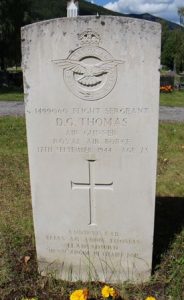
Rhys Stanley Thomas, Private, 10550039, Royal Army Ordnance Corps. Rhys was the son of Thomas Morgan Jones Thomas and Elizabeth Thomas, of Bancyberllan, Llansadwrn. He served with the Royal Army Ordnance Corps. Rhys was accidentally killed whilst on active service on 13 August 1942, aged 20, and is buried at Llansadwrn (St. Sadwrn) Churchyard.